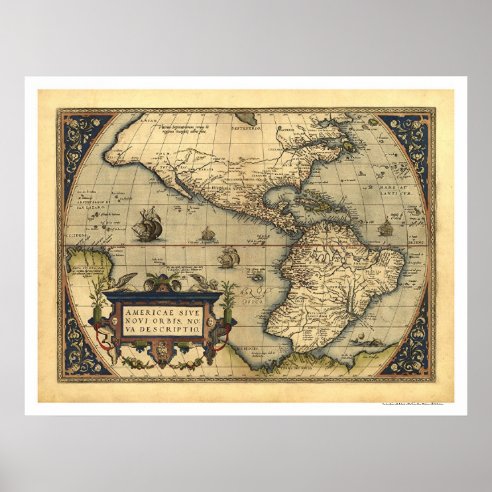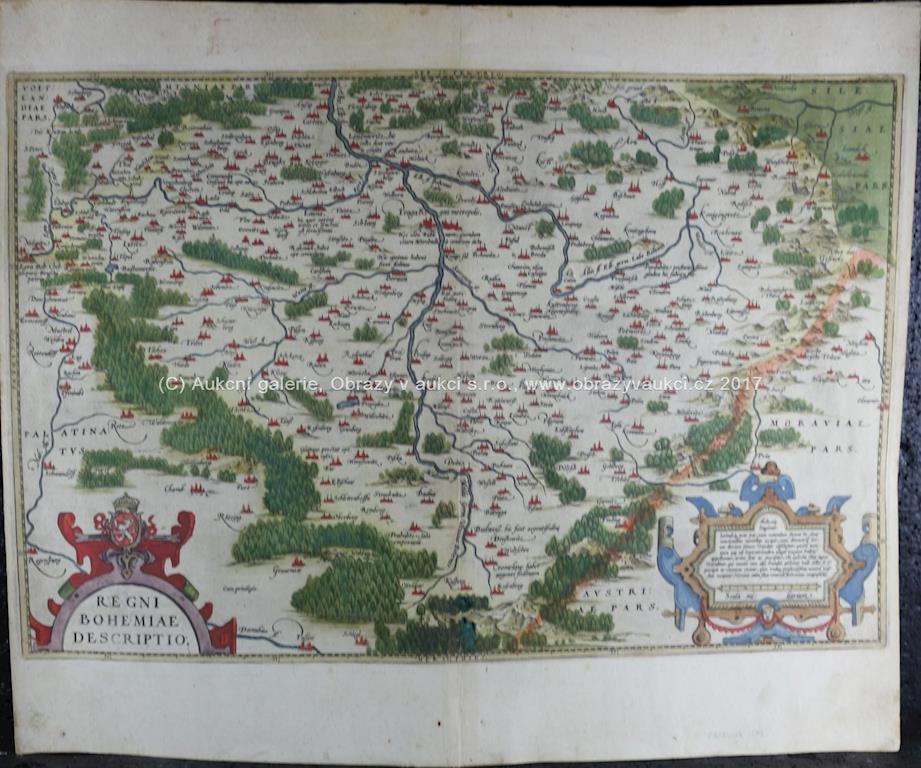

Exploration of the New World continued to excite people in the sixteenth century as colonization grew and more territory was discovered. His map pulls from different disciplines in an attempt to educate a curious society.

Art, cartography, and scholarship combine to make an aesthetically pleasing and informative map. His use of color helps emphasize the coastlines, mountains, and other elements represented. Ortelius uses ships to further convey the Spanish claim to the region, and several galleons with Spanish flags are depicted off the coast of Peru. Ortelius explained away these texts as filler for what would have otherwise been blank spaces. His description of Florida was particularly colorful as he described the natives as barbarians who ate spiders, serpents, and all sorts of venomous creatures. He excitedly told of all the gold that had been found in the area. Ortelius wrote about the climate in Peru, comparing it to Spain. The Latin text on the back of the page can offer modern scholars an insight into the minds of their sixteenth century counterparts.

The contrast illustrates what little information the public had on early exploration of the Americas. By comparison, the rest of the world was given a staggering 105 maps. This map was one of seven of the New World added in 1584 to the Theatrum. By using letters and travelogues from explorers such as Ponce de Leon, Cabeza de Vaca, and Vazquez de Allyon, Ortelius attempted to create a better understanding of the spaces. Ortelius pulled these maps together onto one page and contributed descriptions of each map on the back of the page. The creator of the Guastecan map is unknown. The map of Peru is attributed to Didaco Mendezio, about whom little is known, while the image of Florida is attributed to Jeronimo de Chaves who had copied an earlier manuscript map by Alonso de Santa Cruz. Summary Tags Date Source Link Copyright info labeloutline Explore 1608 Maps, Media Contributed By The Folger Shakespeare Library, Theatrum Orbis Terrarum. As a result of engravings, the maps of others were available for Ortelius to borrow for his own atlas. Ortelius cannot be credited for creating any of these maps. The locations of different Indian settlements are documented, but little else.

Ortelius did his best to provide this, but had little information available, as he had never been to South America. At the time, there was public demand from well-educated elites for an image of Spain’s new territories that had arisen from the growing imperial emphasis on discovering and colonizing the New World. Ortelius’ map was produced for the third edition of the atlas, Theatrum Orbis Terrarum, which is considered to be the first modern atlas. The map shows three different regions of South America claimed by Spain: Peru, Florida, and Guastecan. While maps depicting this New World were likely created prior to 1584, Abraham Ortelius’ Peruviae Auriferae Regionis Typus is one of the first widely published maps of the area. Weak oppose, though I'd support a less extreme crop readily.The world changed in 1492 when Christopher Columbus set foot in the Bahamas and claimed the New World for the Crown of Castille, modern day Spain. Aunque el mapa de Ortelius es anterior al descubrimiento oficial de Australia en 1606, el mapa presenta una enorme masa en la base, identificada como Terra Australis Nondum Cognita (Tierra Austral No Conocida), lo que revela que los exploradores ya estaban formulando hiptesis sobre su existencia, pero an no la haban probado del todo. A 1570 map will not have razor-straight edges in its original form. I'm uncomfortable with the cropping out of the borders.Support as nominator - Indefatigable2 ( talk) 16:56, 2 July 2013 (UTC) Reply.Reason A high resolution scan of the famous world map from the first true modern atlas, created by Abraham Ortelius and published in Antwerp Articles in which this image appears Abraham Ortelius, Age of Discovery, Commercial Revolution, Early world maps, History of cartography, Prime meridian, Theatrum Orbis Terrarum, World map FP category for this image Creator Abraham Ortelius Three Latin editions of this (besides a Dutch, a French and a German edition) appeared before the end of 1572 twenty-five editions came out before Ortelius' death in 1598 and several others were published subsequently, for the atlas continued to be in demand till about 1612. Original – In 1570 (May 20) Gilles Coppens de Diest at Antwerp published 53 maps created by Abraham Ortelius under the title Theatrum Orbis Terrarum, considered the "first modern atlas".


 0 kommentar(er)
0 kommentar(er)
